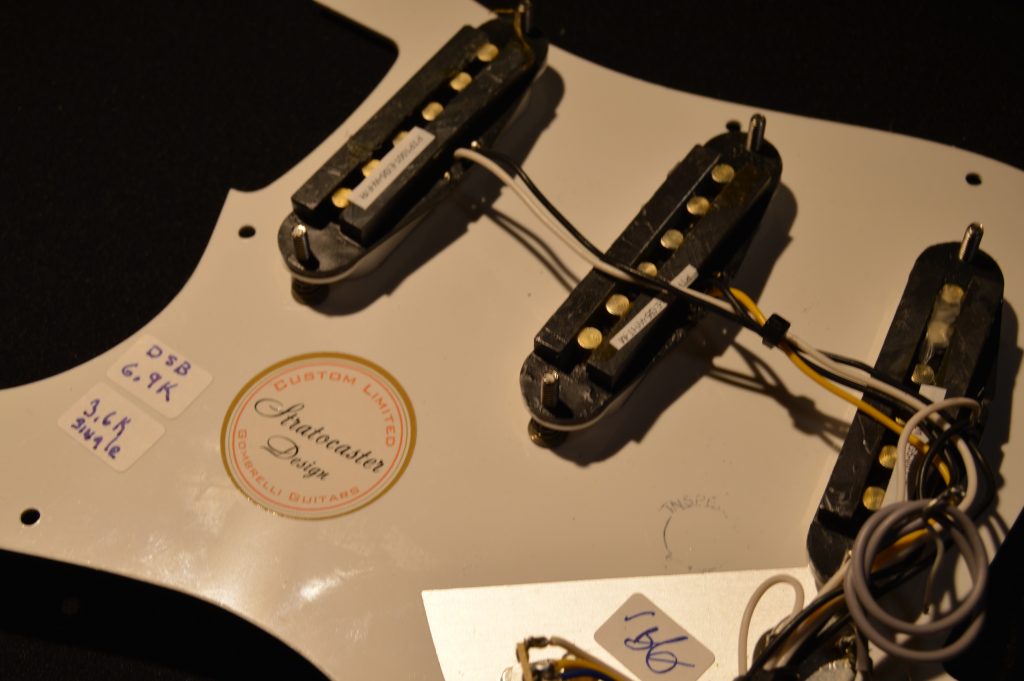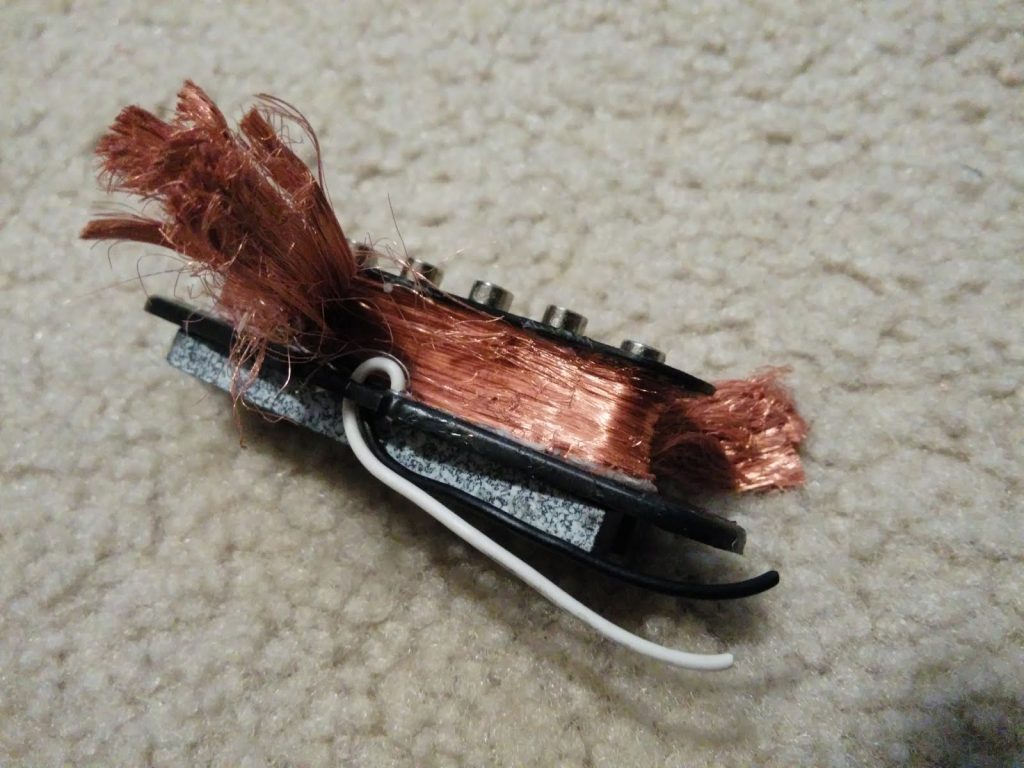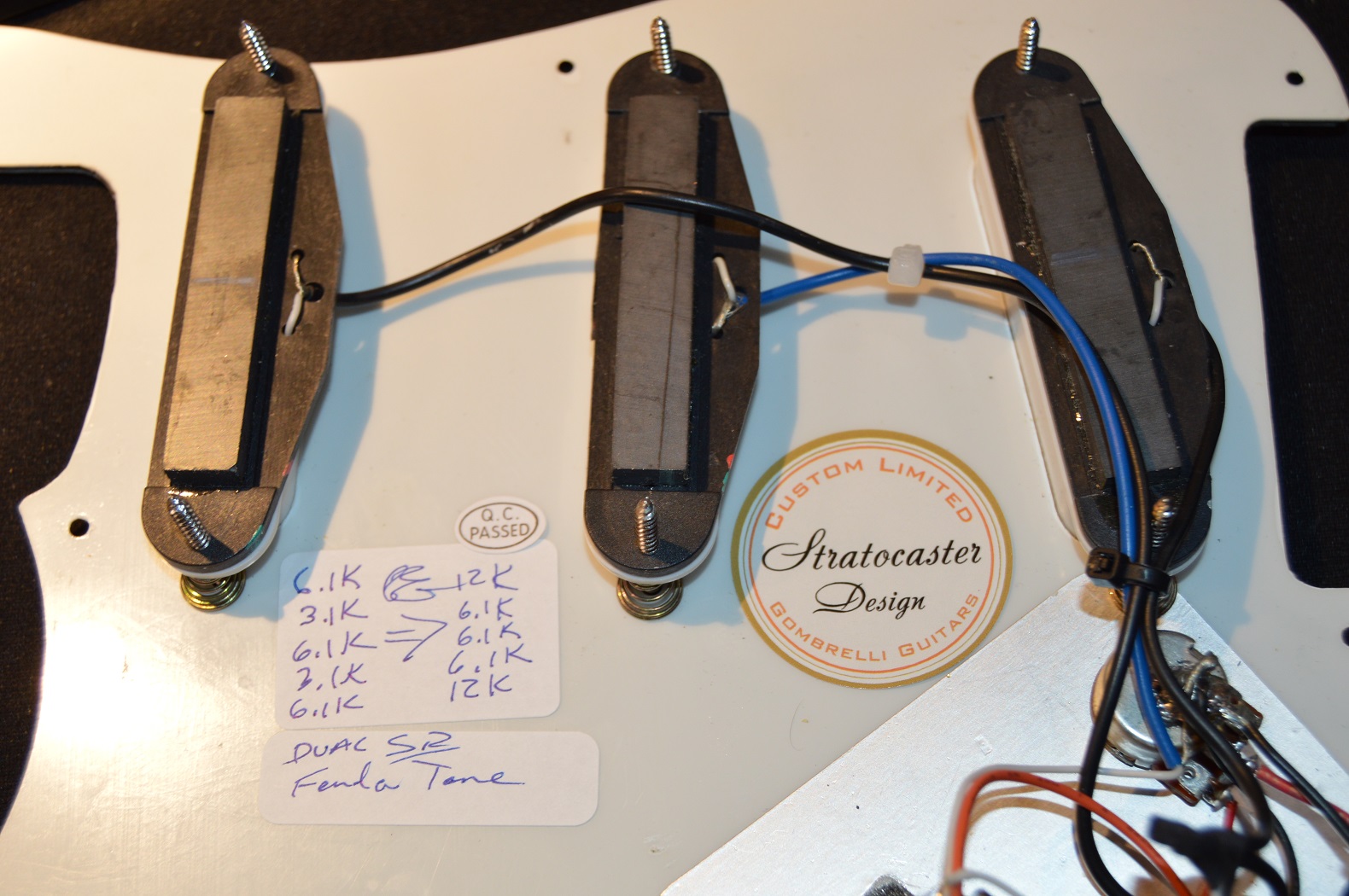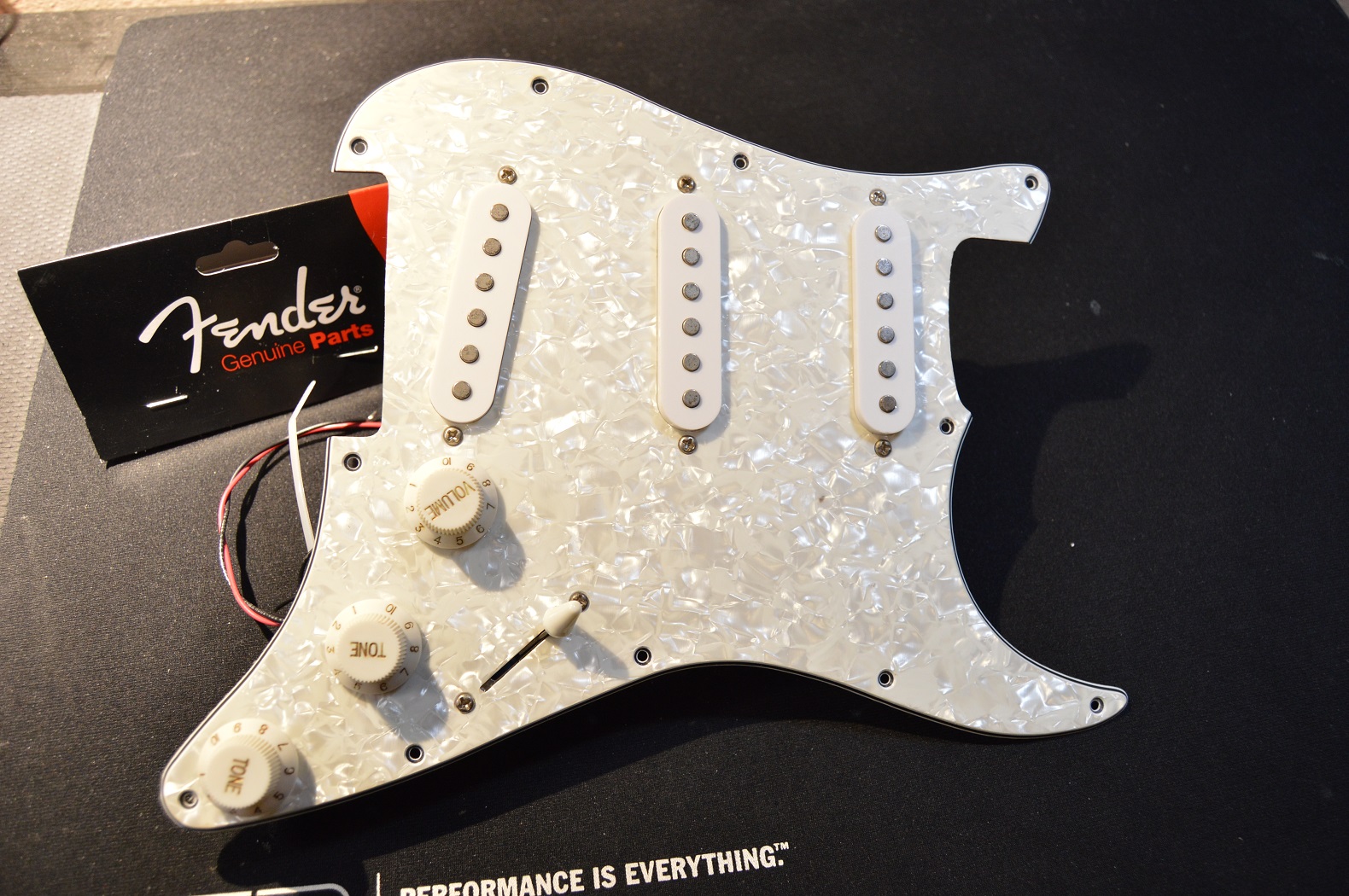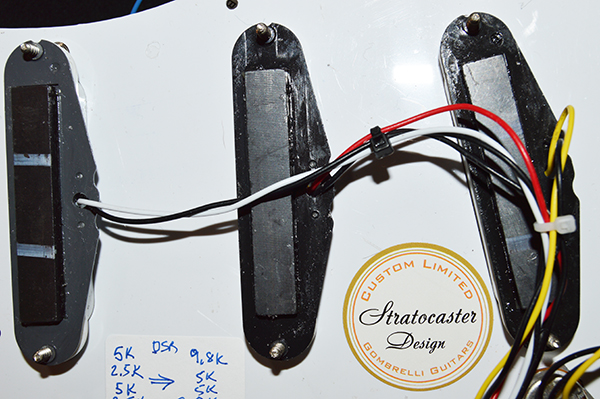All the information was gathered by Bruce Gombrelli of Gombrelli Guitars USA. Please give reference if put it on your website or a wiki
Updated: 2024.09.08 – Separated out Squier Pickups from MIM
Identifying Fender pickups ranges from an easy to a difficult job at times. These pages are a labor of love for sure! I focus on the newer Fender pickups for now.
NOTE: This information is subject to change and I’m updating it all the time as I run into new or conflicting information all the time, so more pickups are getting added and the editorial comments are getting updated constantly. And of course, they keep making new models!
FIGURING OUT PICKUPS
A great place to start is here: Fender Pickup Check List
Fender typically has no “set” look for their pickups and often no number scheme or another unique identifier written on the pickup itself, usually the number of the pickup represents some or all the SKU when it does exist, but not always are all the numbers written or even written on them at all.
The best way to identify them is often by looks and measurements combined. That said, some pickups, like the noiseless ones, are very easy to identify other can be dog gone hard. Bottoms, Wires and such make it a complete detective project at times because Fender would use whatever pickups they had on guitars in some cases so an MIM could show up with higher end pickups, or test runs, etc.
Big Picture Info
- Don’t be fooled – The “Number” on the back of the pickup is usually a middle number in the actually part number or part of the part number, and this may change over time for the same model of pickup. Sometimes it’s rock solid so examine with caution.
- The number that is “molded” into the plastic is a BOBBIN NUMBER and is used over and over in different pickups. That just the plastic part number and is worthless for identifying pickups.
- The resistance values are approx. and can vary up to 10% in some cases or even more. The DCR are a guideline, not an absolute but in some cases they are very close.
- Pay attention to the stock wires used.
- Pay attention to the staggering on the poles.
- DCR is only PART of the sonic equation!!
INDUCTANCE
Inductance varies by the frequency used to measure the inductance and the technique used. The recommendation is to use 120Hz and make sure you measure using SERIES mode. This will get you values very close to what Fender publishes and the difference at that point should be the actual pickup.
Q VALUES
The Q Value (the width of the frequency notch) changes by measurement frequency and since the Q on pickups is quite wide, expect a 0.3 ish value and use 120Hz the same as you use for inductance measurements.
GAUSS
I don’t have a lot of Gauss readings but see my Magnetic Pole info page. Note that most Guass meters measure in Telsa, just multiply by 10 to get Gauss.
This page contains SQUIER Pickups. Expand Single Pickup Links to search for other pickups like USA or Custom Shop, Humbuckers, etc.
Overview
Squier pickup are all over the place but there are some common modalities. And pickups like Classic Vibe 50 and Classic Vibe 60s tend to be better quality and more consistent.
How to tell the difference between MIM and SQUIER Ceramics
From the bottom they look very similar but there are some definite differences.
- The E’s pole tops are slightly lower on the MIM ceramic
- The wire connection on the bottom of the pickup is different. The Squier are very small and hard to tell, on the MIM they are more like standard larger blobs of solder.
- The bottoms of the poles are slightly beveled on the MIM and just cut off on the Squier
- The Squiers often come with a sticker on them, the MIM never has that.
- OF COURSE they measure different but you may not have a ohm meter on line 😉
- The bottom of the pickup has slight RAISED part where the screw mounts in, the Squier is flat
- There are notches in the bottom where the wires solder to the wires with a Squier
- Overall the build is better on the MIM.
(NEW) – SQUIER SONIC CERAMIC
These will fool you. The tops have the classic “Squier” Swirl so they are using the same steel posts but the bottoms, although they look like the old standard, look much neater and more like standard MIM! And their measurements are almost twice as high as the older Squier Ceramics so you only clue is the measurement and that the magnets look cleaner cut.
These pickups are a LARGE improvement over the older dual magnet squier and act more like older MIM ceramics. They measure in about 5 to 6K which is really kind of in the sweet spot. They have more windings however because the inductance is a tad higher but they are an incredible bang for the buck. Nice update Fender, you sometimes get it right!
- Top: Pole Pieces are the same and have a swirl on the them.
- Measurements: Measured in circuit with pots full on (roughly 5% reduction of true DCR)
- Neck: 5.6K
- Middle: 5.8K
- Bridge: 6K
- Inductance: from 3.7(neck) to 4.1H (bridge)
- They are DIFFERENT values, they actually cared enough to do that!
- 2 Bar Magnets that look very tidy compared to older ones
- Staggered
- Bridge and Neck are white with Black ground
- Middle is RWRP with Yellow and black ground
- Pickguard: Same as before, Same Pots, Same Switch – only the pickups have been upgraded.
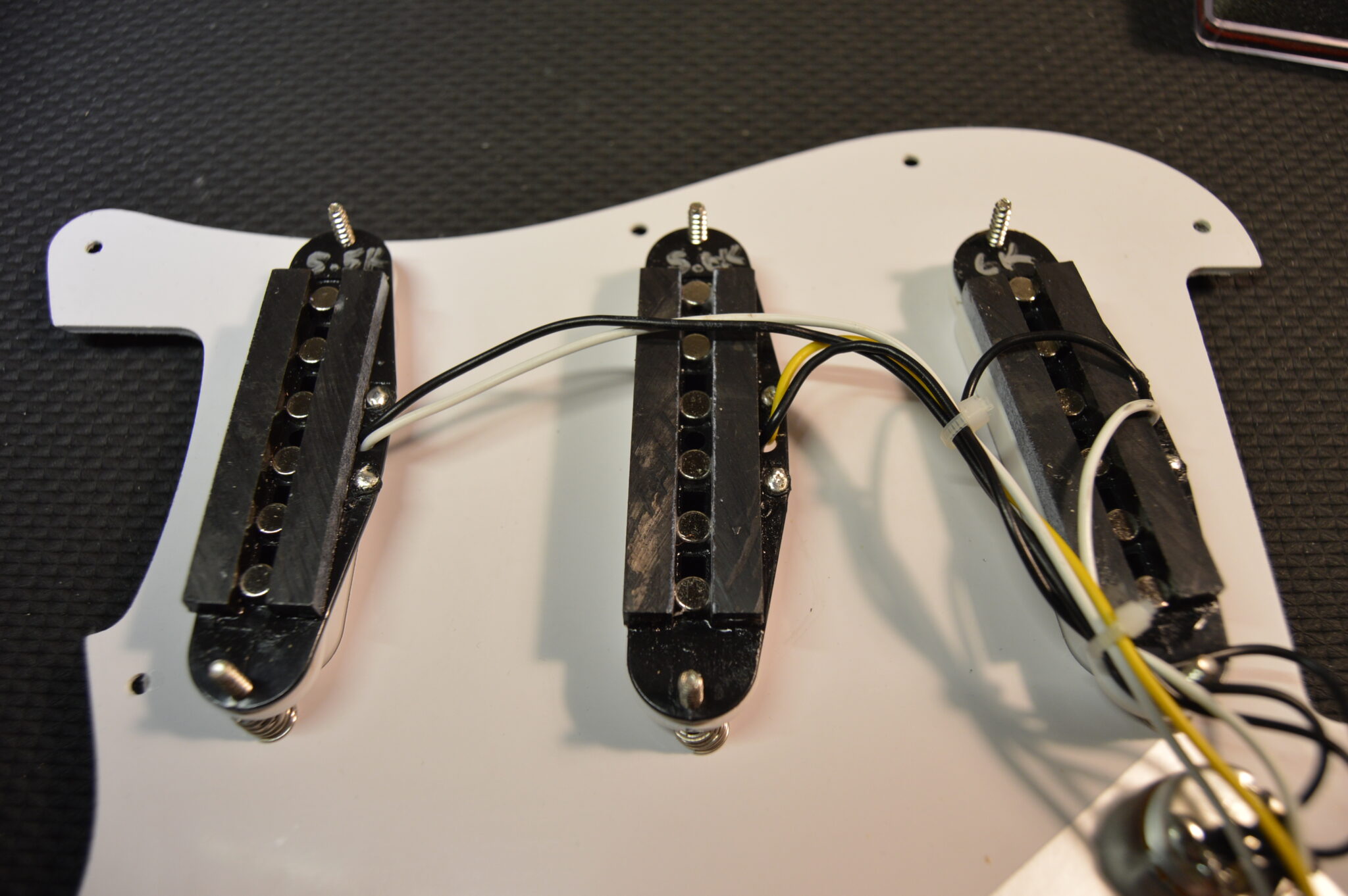
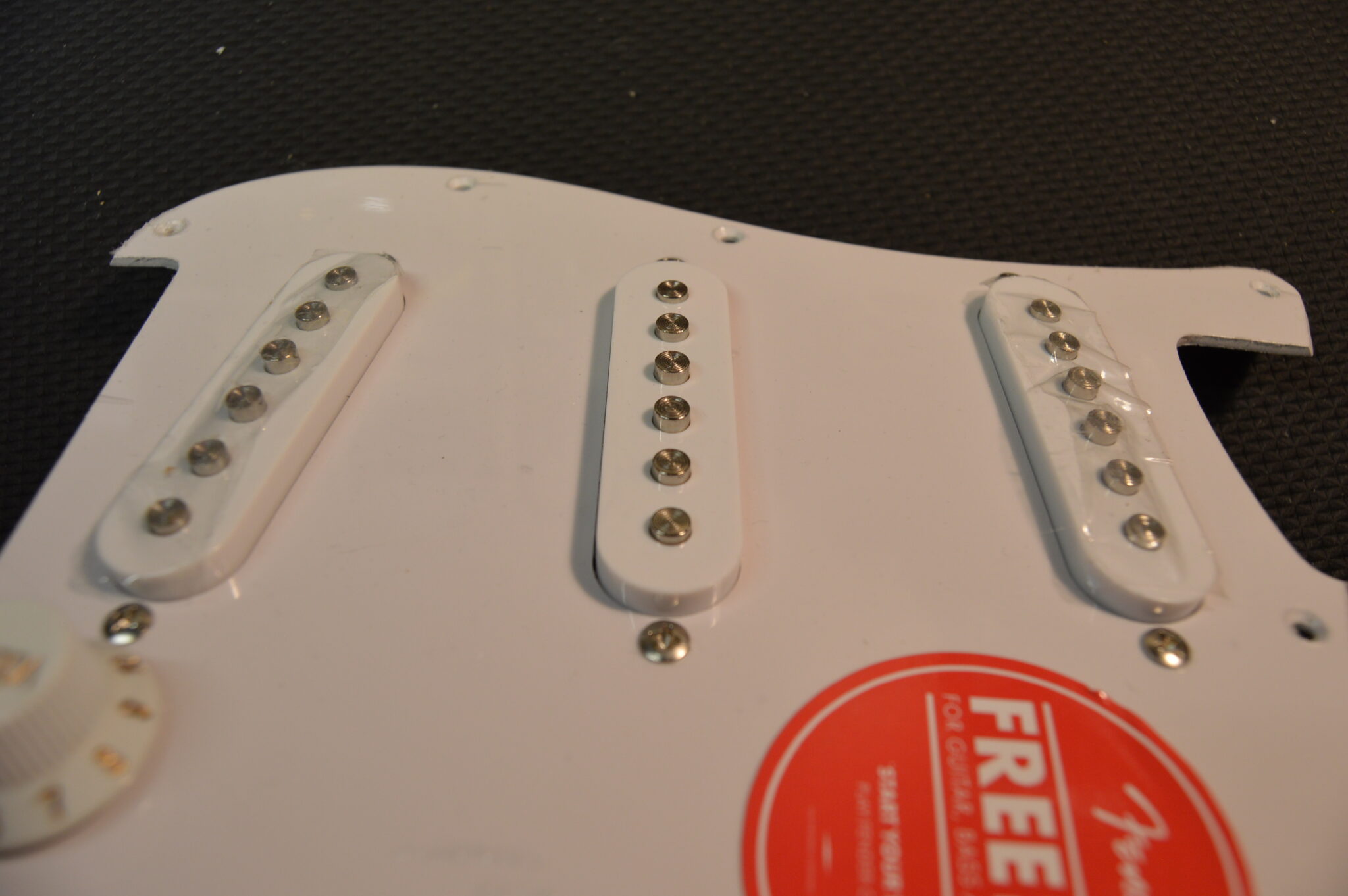
CLASSIC VIBE 50s/60s/70s – WHICH ONE?
Update 2024.04.06
This is rather a mess but the new pickups are pretty solid.
The info below is to the BEST of my current knowledge. The pictures on the internet can be very wrong as to if a person has a 50s, 60s or 70s classic vibe pickguard so this is a helpful guide
**** One the plus side, these guys are GREAT Bang per buck pickups and sound quite good!! *****
Essentially you can get any pickup on any version or any switch, the only thing that is consistent is that there are only a few varieties of pickups being produced for these. The PTP version are the newer ones that are made in Indonesia, the STA versions were made in China and are the older version. They were also sourced through ToneRider.. The classic vibe moved from This changed China to Indonesia in 2019 (as the rumor goes) – And this made them more consistent.
All these have black grounds and are 2 wire pickups
Some of the measurements (like 60’s Vibe) are quite consistent.
Indonesian Version
- Stickers: strange numbering scheme, but oh well. the WH standard for white.
- MOST of the 50s, 60s and 70s use these pickups.- They are Alnico 5 and sound just fine.
- PTP1011-1-EG5-ADWH-F (front aka neck) – White
- PTP1014-1 EG5-ADWH-M – (Middle) Yellow
- PTP1049 EG5-ADWH-R – (rear aka bridge) – White
- Measurements: (All inductances measured at 120Hz
- Vibe 60’s (verified)
- Bridge: 6.58K — 2.85H
- Middle: 6.6K — 2.63H
- Neck: 5.8K — 2.38H
- Vibe 60’s (verified)
China Version (prior to 2019 the rumor goes) – These Are Classic Vibe 60’s – Not a bad set of pickups, sound decent, good output.
-
- STA3B (fender) PW-1 (Bridge) – Red
- STA3M (fender) PW-1 (Middle) – White
- STA3N (fender) PW-1 (Neck) – Blue
- Measurements (real) –
- DCR: (neck) 5.8K (Middle) 6.1K (Bridge) 6.5K
- Inductance (Neck) 2.7H (Middle) 3.0H (Bridge) 3.3H
I’ve seen these on the 50’s
-
- STA5B (fender) PW-1 – Red
- STA5M (fender) PW-1 – White
- STA5NB (fender) PW-1 – Blue
These pickup are made in Indonesia or China, there’s no way of knowing where for sure at this point however, I think Indonesia are the more newer ones.with the PTP num numbers. They put the PTP on all versions 50s, 60s and 70s.
Other:
- Bottom: Paper, Poles cut even on bottom
- Top: Mild Stagger, pretty much flat cut, some have more stagger
- Wire covering: Plastic Insulated wire, individuals
Switches
- Type 1 Switch (I called it type 1)
- This is the “Classic” rectangle asian strat switch
- Type 2 Switch
- This one is a Asian Clone of the Oak-Grigsby
- Picture Problems: Part of the hassle I’ve seen is the “MIS-LABELING” of the pickgaurds and pickups by sales. For example: some vendors reselling these (LIKE STRATOSPHERE) are MISLABELING the pickguards and are using EXACTLY the same pictures for both 50s and 60s Classic Vibe. Posting error no doubt, or laziness.
Here is some info I found on the Internet. I have no idea how true this is:
Tonerider note : The factory that made the CVs also makes pickups for Tonerider and they have made Fender branded pickups to similar specifications to Tonerider sets:
Strat CV 50 has Alnico iii pickups marked STA5 which are very similar to the Tonerider Surfari TRS5 set
Strat CV 60 has Alnico v pickups marked STA3 which are very similar to Tonerider Classic Blues TRS3 set
MORE INFO:
Further Update and The Move to Indonesia is Complete (Bruce – This definitely looks valid to me)
The Fender USA web site in July 2019 shows the new range it shows that all models are now made in Indonesia some changes are evident throughout all models.
Pickups are no longer the tonerider types but Fender designed Alnico Vs
The pickups on all the strats are the same as follows
Neck PTP 10149 Middle PTP 1014-1 Bridge PTP 1011-1
CLASS VINTAGE 60’s PHOTO
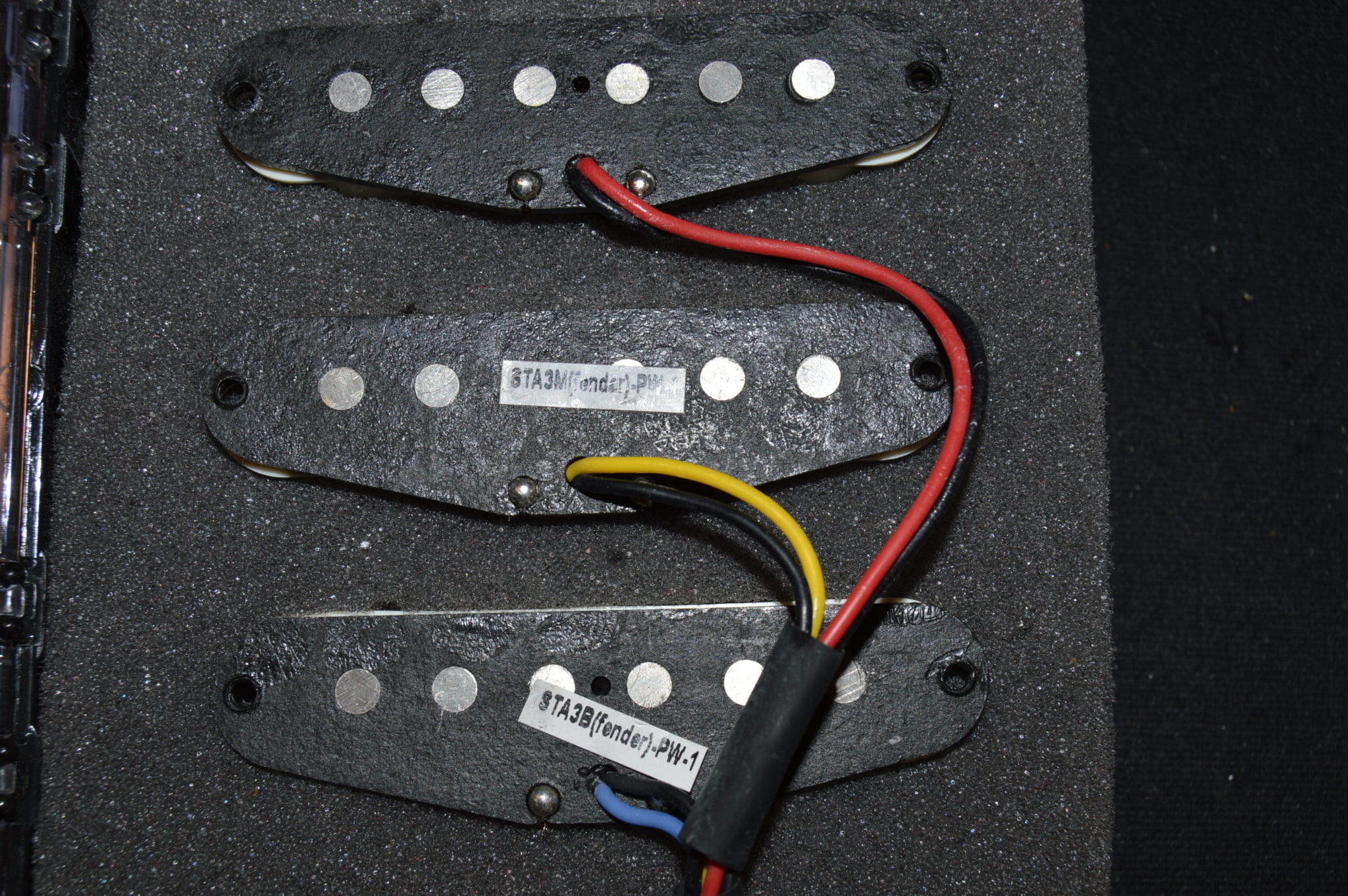
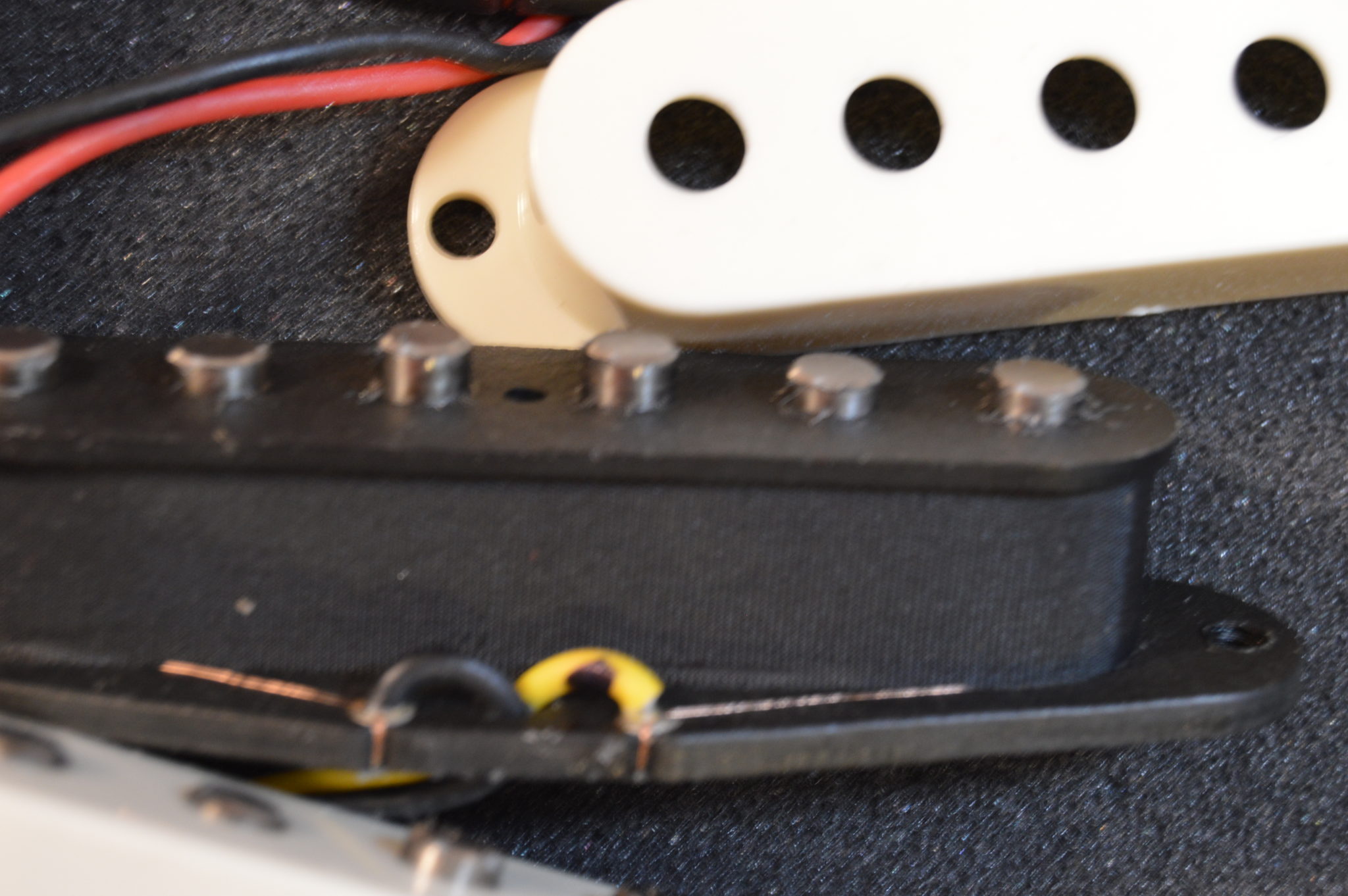
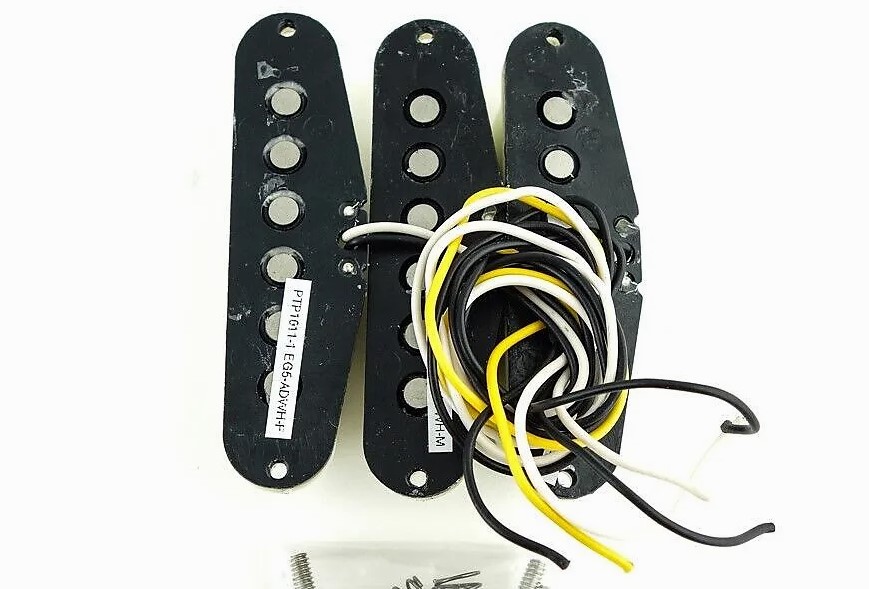
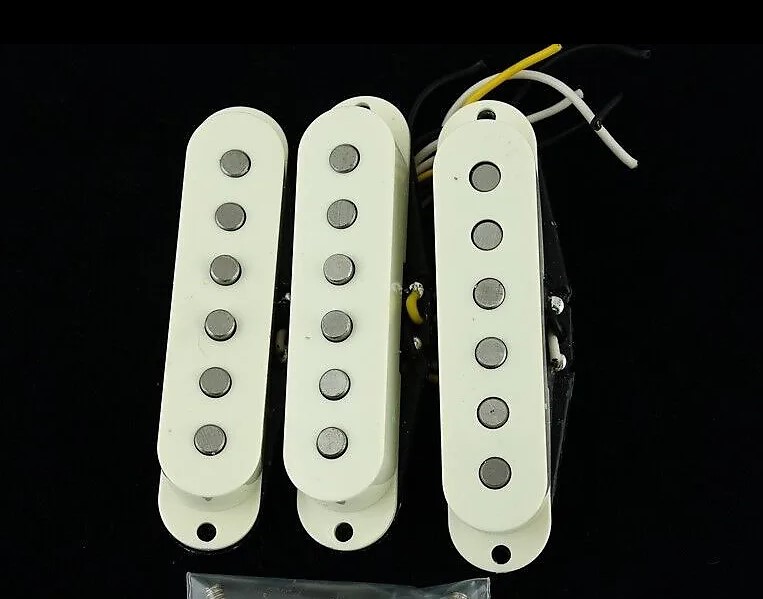
Single Bar Magnet Squier Pickups
Summary: These are sometimes VERY hard to tell apart from all the millions of generic asian made pickups out there. In general their output is lower but they respond ok to a series arrangement making them into vintage humbuckers. The middle pickup is typically RWRP. (Vibe series is a better choice)
NOTE: There are 2 wire versions of these, they are usually higher quality than the “One Wire” versions.
I generally avoid these pickups now. Not well received and bad resale value. I had a few hot rod pickguards using them to give a “low end” option but ultimately decided it just wasn’t worth my time and I didn’t like the quality, so I discontinued them and Squier guitars in general.
Last Updated: 20240.04.06
Single Magnet Squier Pickups.
The BEST way to examine these is with their DCR values because there are different models that look exactly the same except the wires are different.
- There are many varieties of these, some better than others.
- Generally they are all Alnico 5
- Don’t set these too close to the strings
- They ALL tend to have the same value in any given set
- Generally not as in demand as the ceramic versions
- Fender does not say anything about what they are for a given model because they may change at any time depending on back stock.
- There are versions that are 2 wire (and not the single shielded wire). These tend to be slightly better pickups.
Values and Spec (haha):
- 6.1K – Pretty Decent but some say they sound harsh, Good in dual coil arrangements – SINGLE wire with ground and wires inside.
- Alnico 5
Squier Electronics
- Pots: Squiers use Alpha Pots (small guys)
- Switches: There is more than 1 type of switch. Not sure which is best. They aren’t as smooth as a Oak Grigsby and cost less if you want to buy them new on Amazon and are cheaply made with tiny little terminals. I never use them.
Pickguards:
Pay attention to if it’s 11 hole or 8 hole. The patterns on later Squier are very standard, some of the older ones are goofy but the bodies are drillable. Hard Tail pickguards don’t fit anything.
Below is a few pictures of some of them. The bottom ones I was able to get measurements on and I produced a real nice Dual Stratbucker arrangement with them with a very decent sound. As with other pickups like they, they tend to like a light compression.
- 6.1K ALL 3 – 3.1K in positions 2 and 4 (hum cancelling)
- Different wiring arrangements
- Smaller Alpha Pots
- Wires are usually in a single shielded wire, not the usual 2 wire arrangement (which I do prefer)
- Screws are super cheap with sharp ended on the real pickguards.
- The pickguard quality seems ok on the true Squier versions. Older ones are more iffy
- HARD TAIL Squier pickguard are NOT Standard hole positions or cut.
- Some older SQUIERs have a shallow route and don’t fit push/pull switches.
These have single cables that have a wire and a “shield/ground” in it. I actually don’t like dealing with these as much and I prefer single wires by far, and it tends to be a sign of quality.
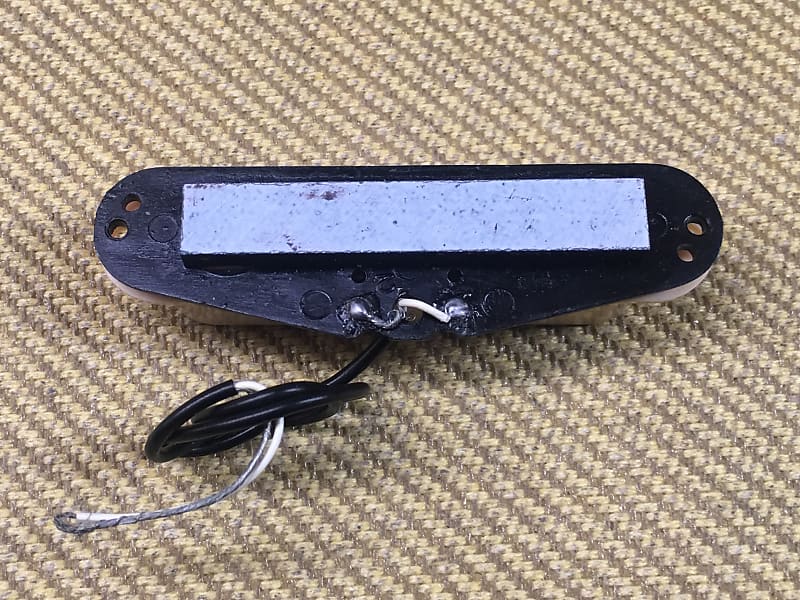
These are 5K values. They have separate wires so they are much easier to deal with. The discontinued line.
Squier Ceramics (old version)
Update: 2024.04.06
Fender Squier guitars have many pickups but there are a few I really want to comment on. The first is their Ceramic. These guys ok but their output is low unless in series. They have a reading about a little over 1/2 DCR of the MIM ceramics but they sound like ok vintage pickups because they are ceramic. With a value of roughly HALF of the value of the MIM counterpart (about 3.7K) they can be a decent cheaper bang per buck (but better choice is Vibe series). With a series arrangement they sound good. Note the the middle one has a yellow lead, and it is reverse wound to cancel hum in positions 2 and 4.
- Some have a sticky number label on them
- They measure around 3.7K (1/2 of the MIM Counterpart)
- 2 Ceramic Magnets with Steel pole pieces (looks like an MIM)
- Swirls on top of the pole pieces
- Bevel: Slight Bevel
- Stagger: Mild Stagger
- Ok for Vintage sounds and BEST when used with a boost pedal (or mild compressor) they are very good
- Lower output is definitely not for everyone (These don’t meet my bar for my lowest price loaded pickguards)
- They are similar to ceramic MIM pickups but have less windings.
- They REALLY want to be in series to create a acceptable Humbucker (around 7.5k)
They are easy to identify because the top of the poles are NOT staggered and they have a swirl on the top unlike the MIM versions have no swirl and are slightly beveled.
Finally some of them have a sticker with a number of them, I haven’t researched that. But since they are so easy to identify with DCR that it really doesn’t matter. Import pickups usually use a SINGLE bar magnet so it easy to identify this as a Squier pickup.
<imgsrc=”https://stratocasterdesign.com/wp-content/uploads/2021/02/DSC_0007-1024×681.jpg”>
